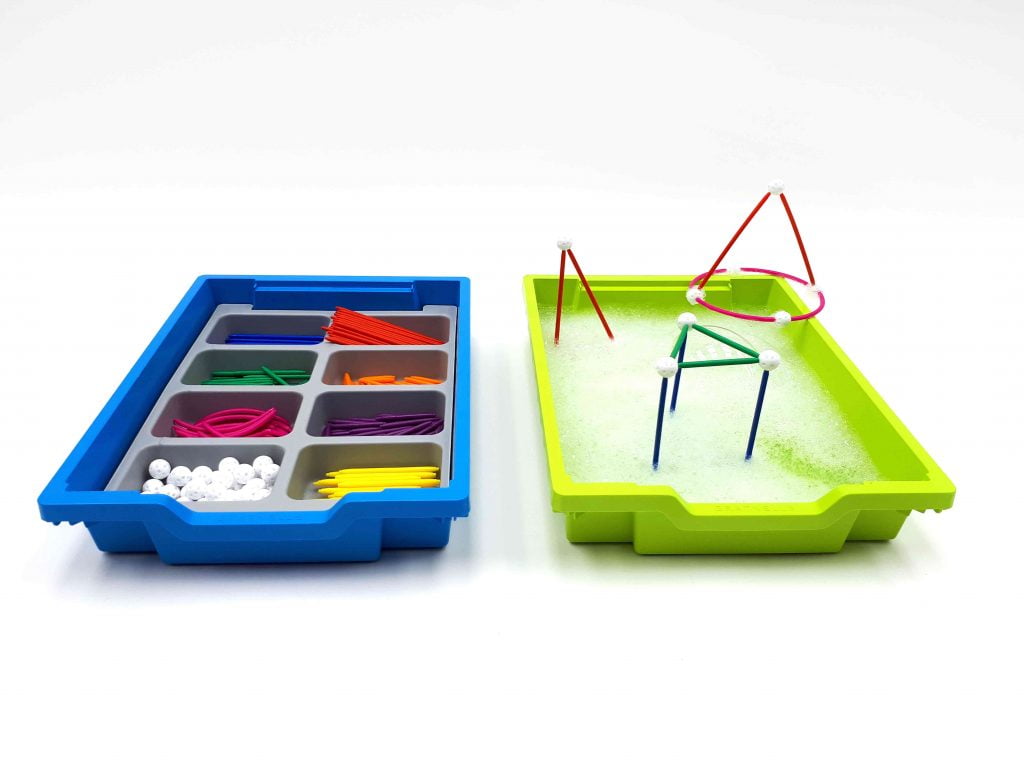Bubble wands
Our bubble wands are made from Edx Education’s Skeletal Geo Set. These excellent math manipulatives can be used to form a wide range of regular and irregular 2D shapes and 3D models and provide a fantastic, practical, opportunity to learn about vertices, faces and edges while constructing new models. They are also great for developing fine motor skills whilst increasing and cementing mathematical vocabulary. Here we use them to build 3D models and use them as bubble wands.
You can keep it simple for younger children or really challenge older or higher ability children by adding in challenges from the ‘other things to try’ section.
Learning outcomes
You will be able to:
- Build and describe a range of 3D shape models.
- Create your own bubble solution and experiment with it to discover which recipe makes the best bubbles.
You will need:
- Edx Education’s Skeletal Geo Set
- 2 x shallow Gratnells (F1) tray
- 1 x 8 section Gratnells tray insert
- Liquid soap e.g. washing up liquid
- Water
- Glycerin (optional)
- Corn syrup (optional)
- Stopwatch (optional)
What to do:
- Group and sort your Skeletal Geo Set into a shallow Gratnells tray fitted with an 8-section tray insert, this will make it much easier to find and use each piece as you need it and to sort and tidy them all away at the end.
- Make a bubble wand from the Skeletal Geo Set, use the video and photographs of our wands to guide you.
- In a second shallow Gratnells tray, make up a simple bubble solution, e.g. 1 part washing up liquid to 8 parts water, enough to half fill a shallow Gratnells tray.
- Dip the bubble wand into the bubble solution and blow gently through the wand to create bubbles.
What is happening?
The secret to a good bubble is surface tension, an invisible bond that holds water molecules together. Water is a polar molecule, it has plus and minus ends like a magnet, these attract each other. When water molecules align, they stick together, creating surface tension.
You may think that it is the surface tension of the water that holds the skin of a bubble together. In fact, the surface tension of water is too strong to make a bubble. You can try yourself to blow a bubble with plain old water, it just won’t work! Most bubble solutions have detergent added to them to relax the surface tension of the water, allowing it to have more elastic, stretchy properties. It then acts more like the skin of a balloon, stretching out nice and thin, trapping air inside of the bubble like a liquid balloon. (Reference: Science Buddies, Bubble-ology).
Inspired to find out more? The Exploratorium has lots more great information about bubbles.

Other things to try…
- Experiment with different 3D shapes, which shape makes the best bubble wand? How will you asses this?
- Experiment with different bubble solutions to find which is the best for bubble making. Make up a new solution but this time substitute some of the water with either glycerin or corn syrup (additives) (e.g. 2 parts washing up liquid, 15 parts water, 1 part glycerin or corn syrup). What effect does this have on your bubbles?
- Try altering the concentration of the additive, what effect does this have? Which solution makes the biggest bubbles? Which bubbles last the longest? Remember to keep the total volume of the bubble solution the same (by adding more or less water) and use the same bubble wand each time to ensure a fair test. What other variables might you need to control?
- To measure which bubbles last the longest, try catching your bubble back on to your bubble wand (this takes some practice) and using a stopwatch to time how long it lasts before it goes pop! You may need to work with a friend to do this. How many repeats will you need to do? Which bubbles last the longest?
- How about making magic bubbles? These special bubbles resist evaporation and are more stable, you can even touch them without popping. The secret ingredient in this bubble solution is a polymer, which adds to the elastic properties of the bubble. An example polymer to try would be white PVA glue.
- Try making coloured or scented bubble solution using food colouring or essential oils – how does this effect the bubbles?
Health & Safety
As with all Gratnells Learning Rooms What’s In My Tray activities, you should carry out your own risk assessment prior to undertaking any of the activities or demonstrations.

